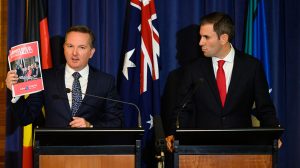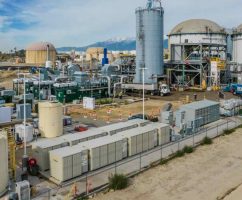It wasn’t supposed to turn out like this. Go back a few months and the intention of the Coalition through its proposed underwriting scheme of new generation investment was crystal clear: Bring in “base-load”and “24/7” power.
And there was clearly one technology that they thought could deliver this: “high efficiency, low emissions” coal plants.
When the shortlist of 12 preferred projects in the hastily arranged FUNGI scheme was finally released on Tuesday, however, three things were absent.
First of all, despite all the talk about new mega projects in the Latrobe Valley and the Hunter Valley, there were no new coal projects selected. Just one relatively small upgrade of an existing plant owned by a Liberal Party donor.
More significantly, there wasn’t even a single reference in Morrison’s press conference on Tuesday to announce this list of “base-load” or “24/7” power.
Instead, the Coalition talked of a shift to “on-demand” power.
And it wasn’t coal that stole the show, it was a range of proposals that combined pumped hydro, battery storage and huge renewables projects that dominated the list and indicated, for the first time, that the Coalition government may be getting a better understanding of what the future holds.
True, the Coalition has included – as we predicted from the very start – a proposal by Liberal Party donor Trevor St Baker to help pay for an upgrade of the Vales Point coal generator that he and his partners bought for a song from the NSW government, and has already made him vastly richer than he already was.
But it was the only one of 10 coal projects put up to the government – including the bally-hooed new coal plants in Latrobe Valley, the China-backed 1GW project earmarked for the Hunter Valley and the proposal to revive the highly polluting Redbank generator – that made it through.
Yes, the Coalition – in an attempt to stave off civil war in the party room – has had to throw a bone to the Queensland club of LNP members and Barnaby Joyce in the form of a “feasibility” study for new coal generation in Queensland, meaning some lucky consultant gets to pocket $10 million.
And it has further teased the back-bench by suggesting some of the new coal projects could make a re-appearance in a later round.
But that’s just nonsense. Whether it is a new coal generator in Queensland, or elsewhere in the grid, for all the reasons we go into here new coal plants do not make sense on financial, environmental or engineering grounds.
They certainly could not meet the government’s target of $60/MWh, and coal costs are going up, not down, in contrast to the trajectory of wind, solar and battery storage.
In short, the Coalition’s tender has confirmed what the experts at the CSIRO and the Australian Energy Market Operator have been telling us: the smartest and cheapest and most reliable options will be a combination of wind and solar backed by some form of storage. Even in the US, this is already clearly upon us, as we report here and here.
The clean energy revolution is upon us, and even a deck stacked with promises of government backing and indemnities can’t hide the fact that coal is dead as a serious source of new investment in Australia.
The needs of the grid and the consumer are shifting from the old paradigm of “base-load and peak-load” to a focus on dispatchability and flexibility, underpinned by what EnergyAustralia describes as a “bed-rock” of cheap wind and solar. (Others’ like Bloomberg’s Michael Liebreich, prefer to call this “base-cost” renewables).
It remains to be seen what happens to the FUNGI mechanism. The Coalition is likely to lose power at the May election, and contracts aren’t due to be finalised until much later (they have until “mid-year” to present final proposals). Labor doesn’t like the scheme and prefers its own plan for reverse tenders managed by the Clean Energy Finance Corp.
The Clean Energy Council doesn’t like it, and neither do many other renewable energy developers – with the exception of those that made the shortlist. They say it is rushed and disorganised, and on that they are most certainly correct – the shortlisted candidates have not even received written advice.
They say it is unnecessary government intervention that is crowding out private investment (although RenewEconomy struggles to understand the distinction from other state-based schemes in ACT and Victoria which have done exactly the same, albeit in a more organised and strategic fashion).
Still, it is clear from this process that both the technologies and the language has shifted, and the six renewables and storage projects that made the shortlist give an insight into what the future holds.
 First, there is the Sanjeev Gupta’s proposal to turn around the fortunes of the Whyalla steelworks, and other big energy consumers in the region. This involves a shift to green energy, including in his proposal for a 260MW solar farm, a 100MW/140MWh battery, and a 220MW pumped hydro facility with six to eight hours of storage located in an old iron ore mine.
First, there is the Sanjeev Gupta’s proposal to turn around the fortunes of the Whyalla steelworks, and other big energy consumers in the region. This involves a shift to green energy, including in his proposal for a 260MW solar farm, a 100MW/140MWh battery, and a 220MW pumped hydro facility with six to eight hours of storage located in an old iron ore mine.
Gupta says these projects will deliver electricity “at globally competitive prices”, reduce current costs, and likely be even lower with government providing clarity over revenues, and filling in the gaps from commercial contracts.
“Funding support from the Commonwealth via (the underwriting scheme) will underpin, and hasten, the sectoral transformation currently underway,” Gupta said in a statement. “This project looks to evolve a primary use from mining to creating sustainable clean green power generation.”
Other projects are even more ambitious. UPC is proposing a massive 700MW solar farm between Armidale and Uralla, supported by a 100MW/200MWh battery and a pumped hydro facility in New England (in and around Joyce’s electorate).
The aim of this combination is clear – solar to provide cheap power, batteries for fast response, frequency control and grid security and short-term fluctuations, pumped hydro for time shifting and storage and peak demand.
UPC is backed by Philippines-based Ayala Corporation, and has an eye on big investments. It is also proposing a 1,000MW wind farm on Robbins Island off Tasmania, that could go ahead at full capacity if another short-listed pumped hydro candidate – Tasmania’s “battery of the nation” project and its associated link to the mainland – ever goes ahead.
Rise Renewables, a company headed by two former Macquarie Group bankers, Brer Adams and Sam Cooper, is looking to combine a 250MW pumped hydro project with eight hours storage at the existing Baroota Reservoir, north-east of Port Germein and near the Remarkable Ranges, with the 300MW Bridle Track solar farm nearby.
Even St Baker is excited by pumped hydro. He proposes a pumped hydro project of 230MW in capacity and 1840MWh of storage, known as the Goat Hill project, 12km west of Port Augusta.
One thing that St Baker will notice about Port Augusta these days is that it is no longer home to a coal generator, and is now surrounded by an ever growing number of wind and solar projects, including the Bungala solar farm, nominally Australia’s largest built to date, and right next door to his own hydro plan, the 212MW Lincoln Gap wind farm, which will also have its own battery.
Indeed, St Baker is also taking a fancy to solar, unveiling a 50MW project near Vales point, and another 270MW solar project that might have been used to pretty up the Vales Point extension proposal. But he can’t argue that wind and solar are not the cheapest generation technologies, he just disagrees about the need for storage and back-up.
Whatever happens to this underwriting program, and these projects, it does seem clear that finally – finally! – the government is catching up with the technology shift that is at hand; and the thinking of AEMO, which like other grid operators around the world has all but eliminated terminology such as “base load” from their vocabulary.
The future is about that “bedrock” of wind and solar, filled in with storage, and other “dispatchable” technologies such as demand response and other demand-side solutions. If $60/MWh is the government target, then it will only get there with these technologies.
(And it should be noted that of the five gas projects included in the short list, the only one likely to get approval would be the small fast-start generators, designed for maximum flexibility, proposed by the likes of APA Group).
It’s all about a cleaner, smarter, faster grid. And if regulators and rule-makers keep up, it will be cheaper too. The Coalition, or at least members of it, are showing signs that they are coming on board, although probably not yet ready to admit as much in plain language.
(Update: Energy minister Angus Taylor is back using the terms baseload and 24/7 power, so perhaps this will be a gradual process, at least not to scare the baseline beliefs of the Far Right).










